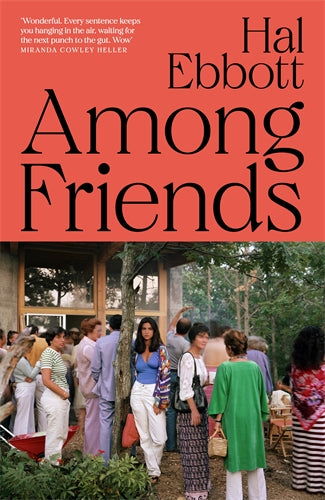Hal Ebbott
Among Friends
Among Friends
Couldn't load pickup availability
Among Friends examines betrayal within the sanctuary of a defining relationship, as well as themes of class, marriage, friendship, power, and the things we tell ourselves to preserve our finely made worlds.
SAM'S REVIEW
I was alone, reading on my sofa when the act of violence that defines Hal Ebbott's debut novel, Among Friends, took place. I immediately put the book down, stood up and paced the room, so agitated was I by what had happened, so anxious was I at what would now take place. The act itself is told in a blur, but Ebbott knows precisely what he is doing.
Among Friends begins with Claire, Amos and their daughter Anna travelling to the upper-state New York summer house of their longstanding friends Emerson, Retsy and their daughter Sophie, to celebrate Emerson's 52nd birthday. Claire and Emerson are childhood friends, Amos and Emerson friends from college, and it was Emerson who introduced Amos to Claire. Their lives are intertwined, their successes shared, and failures yet to trouble their adult lives.
Claire, Emerson and Retsy have only known privilege. Amos, however, spent his childhood in poverty and desperation. The differences between them are unspoken but present, revealed in body language and emotional reactions. While Emerson has the kind of smile "that can only belong to a man: it had no sense of history; it seemed unaware of the world", Amos's confidence treads lightly: "[p]ostures of rigid conviction didn't suit" him. What he preferred was something softer and more considered."
After recent novels like Kiley Reid's Such A Fun Age and Entitlement by Rumaan Alam, and television shows Succession and White Lotus, we know what these differences mean and where these tensions will lead. Ebbott's skill is in telling us that we're correct in thinking this world is about to fall apart, while maintaining our unease about when and how.
He does this by continually moving the target of the tension. One moment it is the irritations of marriage - "He wanted to bury a knife in her lazy reply"; the next, the mothers’ judgements of their teenage daughters: "…she moved with the arrogance of the appraiser, one who thinks themself fit to decide something's worth. It was misused. It must be taken back." This deft touch means that when the violence does occur, it seems to erupt from nowhere, despite the signposts littered in its wake.
I've been back and forth on whether to say what happens and to whom but decided that to reveal this would lessen the impact of the violence and the ruptures that it causes. The weight it carries felt almost unbearable to me because of how beautifully Ebbott has conveyed the importance of the relationships involved: “…the love of friends is a gravity - debris is drawn toward it without knowing why. Romantic love seals itself off, it pairs and withdraws. But friendship is a ladder: it’s something you climb, its two hands knit together to let you see over the fence.”
While the story returns to the wider impact of the violence in the latter stages of the book, immediately after the act the focus narrows to the victim. As the razor blade edge of the earlier sentences dull, we're made to feel the loss of control and identity, the uncertainty, insecurity and confusion that the victim feels. Once again, Ebbott's touch is deft, conveying the bewilderment felt at such a betrayal in the contrasts of daily tasks and lifelong trauma: "how could the person who'd done what they'd done also take such delight in the way bread hissed on a pan?".
The final third of Among Friends picks at the seams of the friendships and family ties: who believes who, who is prepared to upend their lives to do the right thing and who is prepared to overlook the truth to keep things as they ever-so-comfortably are. The families are split: "stood apart, bodies timid, concave. Like parentheses clutching dates, their history was between them." For me this was the most interesting and memorable part of the book. While my gut hated characters for their decisions, my head understood why they made them. When decades of history are at stake, even the most logical, the most loyal, the most correct of decisions becomes clouded.
Among Friends is a startlingly good debut. Ebbot’s ability to switch his writing style to fit the context of the characters’ lives is remarkable for a novice writer. His understanding of our worse tendencies, our pettiness and arrogance, feels beyond his years. The violent act may have left me shaken and pacing, but it’s the ripples and waves of the aftermath that will keep me thinking about Among Friends.
PUBLISHER REVIEW
'Finely calibrated…[A]s discerning as it is pitiless.'
The New Yorker
'Masterly'
John Banville
Who would you choose to believe?
Amos and Emerson have been friends for thirty years. Despite coming from vastly different backgrounds, the two men now form an enviable portrait of middle age: their wives are friends, their teenage daughters have grown up together, their days are passed in the comfortable languor of New York City wealth. They share an unbreakable bond, or so they think. Now, it is Emerson’s birthday, and Amos and his family are heading upstate to celebrate in Emerson’s beautiful home.
Over the course of the weekend, rivalries emerge and tensions escalate, until a final shocking act of violence threatens to tear the two families’ finely made world apart. In its wake, each of them must choose: between whom and what they love most.
Written with hypnotic elegance and molten precision, and announcing the arrival of a major literary talent, Hal Ebbott’s Among Friends examines betrayal within the sanctuary of a defining relationship, as well as themes of class, marriage, friendship, power, and the things we tell ourselves to preserve our finely made worlds.
Share


